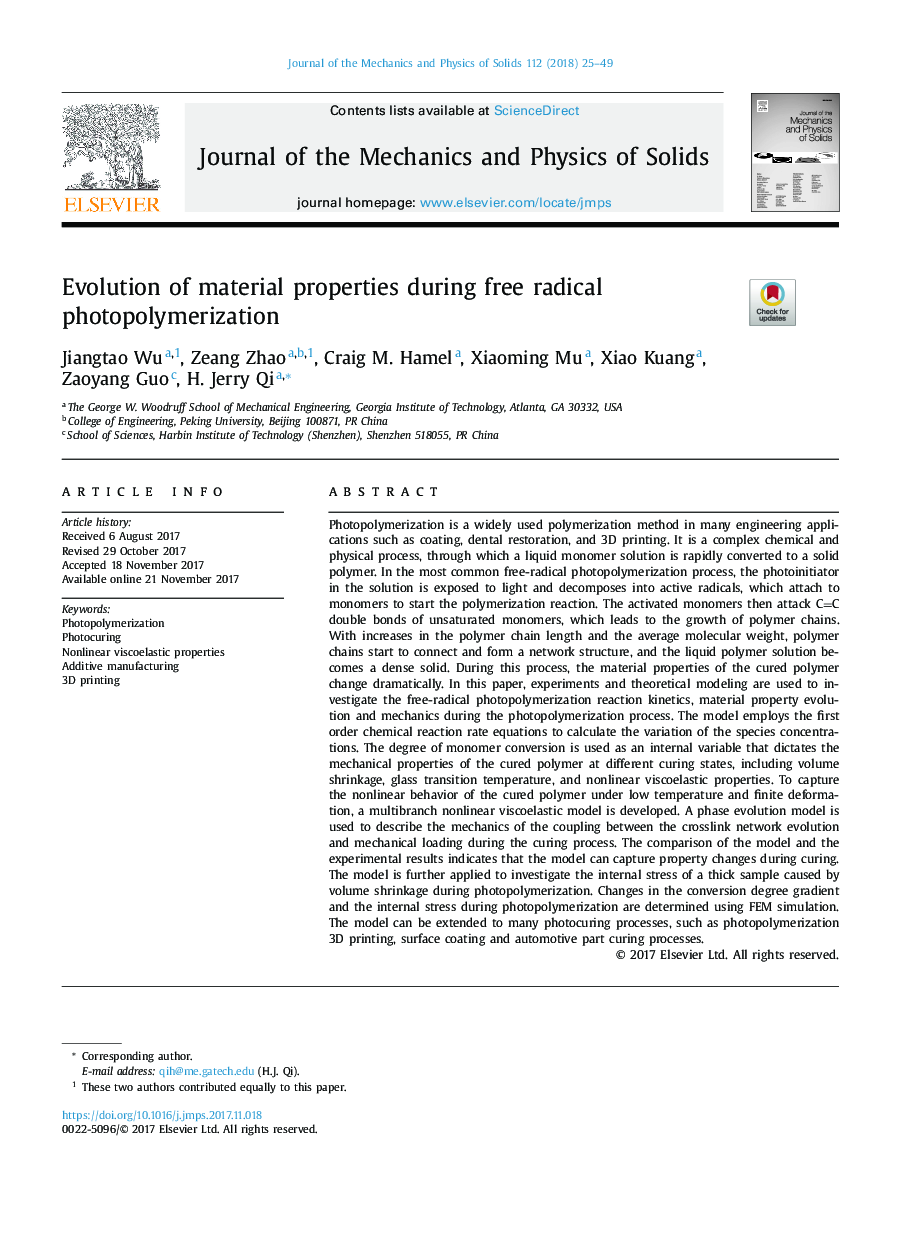| کد مقاله | کد نشریه | سال انتشار | مقاله انگلیسی | نسخه تمام متن |
|---|---|---|---|---|
| 7177493 | 1467031 | 2018 | 25 صفحه PDF | دانلود رایگان |
عنوان انگلیسی مقاله ISI
Evolution of material properties during free radical photopolymerization
ترجمه فارسی عنوان
تکامل خواص مواد در فتوپلیمرسیون رادیکال آزاد
دانلود مقاله + سفارش ترجمه
دانلود مقاله ISI انگلیسی
رایگان برای ایرانیان
کلمات کلیدی
عکسبرداری، عکسبرداری، خواص غیرخطی ویسکواللاستیک، تولید افزودنی، چاپ سه بعدی،
موضوعات مرتبط
مهندسی و علوم پایه
سایر رشته های مهندسی
مهندسی مکانیک
چکیده انگلیسی
Photopolymerization is a widely used polymerization method in many engineering applications such as coating, dental restoration, and 3D printing. It is a complex chemical and physical process, through which a liquid monomer solution is rapidly converted to a solid polymer. In the most common free-radical photopolymerization process, the photoinitiator in the solution is exposed to light and decomposes into active radicals, which attach to monomers to start the polymerization reaction. The activated monomers then attack CC double bonds of unsaturated monomers, which leads to the growth of polymer chains. With increases in the polymer chain length and the average molecular weight, polymer chains start to connect and form a network structure, and the liquid polymer solution becomes a dense solid. During this process, the material properties of the cured polymer change dramatically. In this paper, experiments and theoretical modeling are used to investigate the free-radical photopolymerization reaction kinetics, material property evolution and mechanics during the photopolymerization process. The model employs the first order chemical reaction rate equations to calculate the variation of the species concentrations. The degree of monomer conversion is used as an internal variable that dictates the mechanical properties of the cured polymer at different curing states, including volume shrinkage, glass transition temperature, and nonlinear viscoelastic properties. To capture the nonlinear behavior of the cured polymer under low temperature and finite deformation, a multibranch nonlinear viscoelastic model is developed. A phase evolution model is used to describe the mechanics of the coupling between the crosslink network evolution and mechanical loading during the curing process. The comparison of the model and the experimental results indicates that the model can capture property changes during curing. The model is further applied to investigate the internal stress of a thick sample caused by volume shrinkage during photopolymerization. Changes in the conversion degree gradient and the internal stress during photopolymerization are determined using FEM simulation. The model can be extended to many photocuring processes, such as photopolymerization 3D printing, surface coating and automotive part curing processes.
ناشر
Database: Elsevier - ScienceDirect (ساینس دایرکت)
Journal: Journal of the Mechanics and Physics of Solids - Volume 112, March 2018, Pages 25-49
Journal: Journal of the Mechanics and Physics of Solids - Volume 112, March 2018, Pages 25-49
نویسندگان
Jiangtao Wu, Zeang Zhao, Craig M. Hamel, Xiaoming Mu, Xiao Kuang, Zaoyang Guo, H. Jerry Qi,
